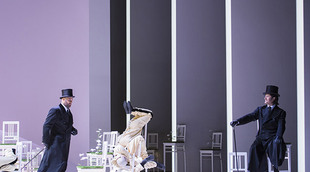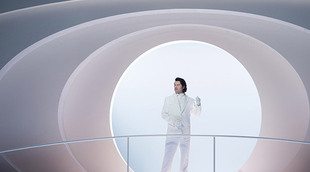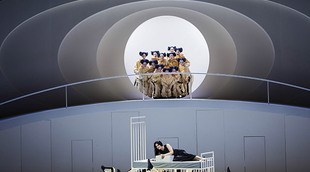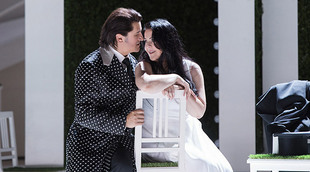 © DR
© DR
Breaking with the image of Goethe’s work (which the writer himself deemed impossible to adapt), Charles Gounod’s Faust is often perceived as a comic opera, a light entertainment fit only for arousing the enthusiasm of the broadest audience, especially with its popular arias (starting with “Je ris de me voir si belle en ce miroir”, popularised by Tintin’s Castafiore). Despite this, the work is far more dense than it seems, revealing Gounod’s conflicts (until then he had been a composer of sacred works), undoubtedly emblematic of French opera of the period and with a depth of dramatic power driven by an irresistibly exciting lyricism.
And for the first time in its history the Salzburg Festival is putting Faust on the programme, in a new production by Reinhard von der Thannen (who intends to explore both “the place of evil, as an integral part of each of us” and “human weakness in the face of seduction”), bringing together Piotr Beczala in the title role, Ildar Abdrazakov as Mephistopheles and Maria Agresta to play the key role of Marguerite. As we await the premiere tonight on Wednesday, August 10, we will examine the issues raised by Gounod’s work.
***
It is said that opera directors who were seeing a decline in receipts from their theatre used to have a miracle solution: re-staging Gounod’s Faust. A veritable anthology of famous pages, the work would draw audiences like a magnet, which earned it in return a sort of affectionate scorn. The work remains, still today, one of the most-performed works as it continues to suffer from the inevitable suspicion that it brings popular success. Should we see in it a sort of brilliant comic opera some of whose arias have become a symbol of the lyric art for the general public? Everyone is familiar with the ridiculous Castafiore and her famous: “Je ris de me voir si belle en ce miroir”, irritating Tintin and others. It is perhaps less well known that this is one of the arias sung by the naive Marguerite who is seduced by Faust with help from Mephistopheles. When Gaston Leroux plays a young female singer in The Phantom of the Opera, he quite naturally assigns Marguerite’s role to her. When Feydeau, in his Chat en poche (1888), tries to ridicule the artistic pretensions of a wealthy bourgeois, he gives him the ambition to “re-write” Gounod’s Faust, and the only aria that the singer taken for a tenor knows is the famous: “Salut! Demeure chaste et pure”… sung by Faust in the opera’s third act. So many ambiguous homages, which most often conceal, behind outbursts of laughter, the real reasons for well-deserved and lasting success.
“Close to the Missions or close to Opera?”
Some prejudices keep us from fully fully appreciating Charles Gounod’s (1818-1893) fourth opera, this Faust which premiered at the Théâtre-Lyrique on 19 March 1859, attracting “le Tout-Paris artistique”. This work was much anticipated because it was thought it would mark the arrival of a composer of whom much was expected.

Piotr Beczala (Faust), Ildar Abdrazakov (Méphistophélès)
Faust © Salzburg Festival / Monika Rittershaus

Maria Agresta (Marguerite)
Faust © Salzburg Festival / Monika Rittershaus
Gounod’s début in the opera world, which was then dominated by the Italians and by Meyerbeer, proved difficult.On the other hand – and this is the other face of this ambivalent figure – his religious music reached its pinnacle in 1855 with the famous Messe de Sainte Cécile, which premiered in Saint Eustache. It was in the 1850s that Gounod would become the Empire’s official musician: he was also the author of the national anthem, Vive l’Empereur. Enjoying huge popularity, he was decorated, showered with honours, named Inspecteur de l’Enseignement du Chant, elected to the Institute, and he was welcomed in the home of Princesse Mathilde or in Compiègne, by the Empress. The musician fit in perfectly with the tastes of the period, combining religiosity and exaltation of bourgeois sentimentalism, both components found in Faust. From there to considering that his success was nothing more than this historical and sociological equivalence, it is a short step, which many took by sticking Faust up on the shelf of likeable curiosities, midway between comic opera and opera. Between the premiere at the Théâtre-Lyrique and the work’s entree to the Paris Opera ten years later, many changes and cuts were to distance Faust forever from its original form, which was still close to comic opera despite the subject’s obvious tragic side. The arias in verse and the spoken dialogue would disappear, and a ballet would be added to satisfy the demands of the Paris Opera.
While Gounod first composed small comic operas like Le Médecin malgré lui (1858) taken from Molière, Philémon et Baucis (1860) and La Colombe (1860) taken from La Fontaine, it was Faust that marked both the début and pinnacle of his opera career. Mireille (1864) and Roméo et Juliette (1867) enabled Gounod to reconnect with success without being able to equal the triumph of Faust, one of the world’s two most frequently staged operas in the world for half a century, the other being Carmen!
All his life, Gounod was torn between two contradictory aspirations, faith and the theatre. Although he showed a keen interest in opera very early on, the young musician composed almost nothing but religious music, as if he were seeking compensation in faith and the exaltation of God for the absence of a father, whom he lost at the age of five. In 1839, the famous Rome Grand Prix opened the doors to Villa Medici for him, a mandatory step for all 19th century composers. His time in Rome proved decisive for Charles Gounod, who discovered, in the Sistine Chapel, the austere music of Palestrina, an aesthetic as well as ethical shock for him. His interest in expressing faith through music was to be a common theme throughout his career. Faust demonstrates this in the church scene in the fourth act as well as in the final apotheosis, which saw the soul of Marguerite, judged and saved by God, rising into the heavens. This grandiose scene progresses at a gripping pace: the score literally “carries” the religious fervour, which has become “spectacular”, as if Gounod had wanted to musically “push the situation to the maximum of its virtualities, its sensitive vibrations”, to borrow an expression used by Jorge Lavelli who was behind a staging of Faust that became legendary (Palais-Garnier 1975).

Piotr Beczala (Faust) © Salzburg Festival / Monika Rittershaus
Charles Gounod’s correspondence is an invaluable record for anyone seeking to understand the composer’s complex personality. A fervent Catholic, the musician was constantly tormented by irrepressible desires that were completely at odds with his feverish mysticism. We seem to hear an echo of this in the words Faust proclaims with cynical joy as he signs his pact with Mephistopheles: “A moi les plaisirs, Les jeunes maîtresses (…) A moi l’énergie Des instincts puissants Et la folle orgie Du cœur et des sens!”. Gounod has often been reproached for making Faust an insubstantial seducer, eager for easy pleasures, while a character like Valentin, Marguerite’s brother, seemed like the defender of a narrow bourgeois morality. The composer undoubtedly projected himself into the moral sufferings of a Faust incapable of withstanding his most basic impulses. Here we are not dealing with the metaphysical questioning that Goethe was so fond of, but rather the moral heartbreak and guilty weakness of a Catholic in the mid-19th century. Moving from despondency to exaltation, Gounod went through serious crises, including one, in 1857, that necessitated his admission to the clinic in Passy run by Doctor Blanche, the famous psychiatrist who also treated Nerval and Maupassant.
When he returned to Paris in 1843 after his stay in Italy, his mother wrote to him: “I don’t know which side you want to be on: with the Missions or with the opera?”. That says it all. He moved in with his mother but lived in the company of the clergy and became choirmaster for the Foreign Missions. In 1846, he went so far as to imply that he had “taken holy orders”. From October 1847 to February 1848, he wore the Dominican habit, asked people to call him “Abbot Gounod” and received a letter from the Archbishop of Paris authorising him to stay with the Carmelites.
“This work would not leave me.”
The night Faust premiered, comments were fairly positive on the whole, although opinions were sharply divided. The praise was mixed with reservations, whereas bourgeois audiences of the Second Empire gradually let themselves be won over. Berlioz, who was also fascinated by Goethe’s Faust, which inspired his La Damnation de Faust (1846), could have been a harsh critic. But he admired several big moments in the score, like the quartet from the garden scene in the third act: “This charming halftone, this musical moonlight caress the listener, fascinate him, charm him little by little and fill him with an emotion that keeps growing to the end”. This judgement could also be extended to the entire work, which constantly uses melodic searches and refinements in orchestration with a tonality imbued with emotion and religiosity, culminating in the apotheosis of the final scene.
Some, like Léon Escudier, emphasise: “a marvellous adroitness in handling the instruments”, while regretting that “It does not constitute dramatic music” but merely “a charming marquetry, a splendid mosaic” that “lacks figures”.
From the start this work has had a reputation for lightness, even superficiality. This impression is reinforced by the popularity of an aria as brilliant as a jewel, a sung waltz (Act 3), or by a chorus as flashy as the soldiers’ “Gloire immortelle de nos aïeux” (Act 4). It may be noted that waltz rhythms punctuate the entire score: the first encounter between Faust and Marguerite occurs amid a crowd carried along by this intoxicating rhythm: “Ainsi que la brise légère: (Act 2, scene 5). Ought we to speak of frivolity, or evoke the erotic aspect of a dance that had just arrived from Austria? Far from pushing the work over to the entertainment side, these waltzes and hymns to pleasure clash with a powerful contrast of religious feeling, conveyed by many choruses, like the Sword chorus: “De l’enfer qui vient émousser nos armes” (Act 2, scene 2) or like the prison chorus: “Anges purs, anges radieux” (Act 5, scene 3). Gounod, who was familiar with Bach’s choruses, scattered imitations of them throughout his work.
The “marvellous adroitness” and “charming marquetry” are however a rather poor match for the philosophical questioning that runs through this vast allegorical drama that is Goethe’s Faust, the source of Gounod’s inspiration! The comparison between the two works is almost always made to the opera’s detriment; it is accused of reducing a sublime tragedy to the dimensions of a petty bourgeois drama Schumann (Scenes from Goethe’s Faust, 1862), Liszt (Faust Symphony, 1857), Boito (Mefistofele, 1868) and, much later, Busoni (Doktor Faust, 1925) appear on the very long list of all those who have attempted to take on, musically, Goethe’s masterpiece, which he began in 1771 at the age of 22 and which he completed in 1831, at the age of 82. Putting all of Goethe’s Faust to music remains an impossible wager. When Eckermann, his secretary, told Goethe that he “does not give up hope of seeing “Faust’ suitably put to music”, the writer replied: “Absolutely impossible. The repulsiveness, the violence, the terror that (the music) would have to express here and there is too contrary to the spirit of our time”.

Maria Agresta (Marguerite)
Faust © Salzburg Festival / Monika Rittershaus
Did Gounod in the end betray his model? As soon as the orchestral introduction begins, the listener is gripped by the dark and deep tonalities that accompany “the fervent vigil” of the one who questions in vain “nature and the Creator”. In his Memoirsthe musician admits to the immediate fascination he felt for the first Faust he discovered at the age of 20, in 1838, in the famous translation by Gérard de Nerval: “This work would not leave me; I carried it with me everywhere, and in the scarce notes I recorded the various ideas I assumed I could use on the day I first approached this subject as an opera”.
While the work seems to have distanced itself from the philosophical issues so dear to Goethe, it is not Gounod who should bear all the responsibility but rather the three-act prose work entitled Faust et Marguerite that served as matrix for the dramatic opera. This piece by Michel Carré was performed in 1850 at the Théâtre du Gymnase, and it fits perfectly into the “light comedy” genre. Librettist Jules Barbier wrote the libretto for Faust based on this piece; its semi-serious, semi-farcical tone blended with the tragic aspect of the love story between Faust and Marguerite. But it may also be considered that these breaks in tone fit perfectly into the aesthetics of French opera, which favour a succession of contrasting tableaux by playing on the mix of registers.
“The Victim redeeming the Executioner”
Gounod long pondered the legend of Doctor Johannes Faust, alchemist and theologian, who is said to have lived from 1480 to 1540. Madly in love, driven by an irresistible fervour towards knowledge but also towards life, Faust sells his soul to the devil in the hope of being regenerated in love. According to Gounod, Marguerite had to be Faust’s “saviour” through “her past sufferings and her present intercession”. “This is the Victim redeeming the Executioner”

Piotr Beczala (Faust), Maria Agresta (Marguerite)
© Salzburg Festival / Monika Rittershaus
After Faust premiered in Dresden in 1861, Germans acquired the habit of referring to the opera as Margarethe, thereby underscoring the importance of this key character: from the garden to the prison, we witness Marguerite’s fall and redemption, while Faust appears enslaved to and manipulated by a Mephistopheles who remains always in control. Marguerite does not appear until the end of the second act, but the plot gradually tightens around her, giving her the dimensions of a tragic heroine. Right from her very first retort, she gives the impression of innocence and fragility: “Je ne suis demoiselle ni belle”. She seems at first glance to be destined for sacrifice, as was La Traviata or as Madame Butterfly would be later. We immediately sense that her love story with Faust will be highly ephemeral, and that only death will untangle the threads of a “diabolical” plot, in the true sense of the word. The famous “Chanson du Roi de Thulé” reveals that she dreams of absolute, eternal love, which in no way corresponds to the very primal desires sought by Faust with the assistance of Mephistopheles. Poor Marguerite!
But if Faust remains still today one of the most fascinating works in the French repertory, it is because it imposes itself through a dramatic power driven by the irresistible fervour of lyricism. Charm always works, blending simple and moving melancholy, flights of passion, exalted prayers and couplets that have remained popular, like those of the “Golden Calf” glorified by Mephistopheles. The illusion of youth, the illusion of love, the illusion of sacrifice, the illusion of power: these themes winding through this shimmering Faust still shimmer and ensure that Gounod’s opera remains a perennial favourite that is not going away anytime soon.
Catherine Duault
the 10 of August, 2016 | Print

Comments (1)